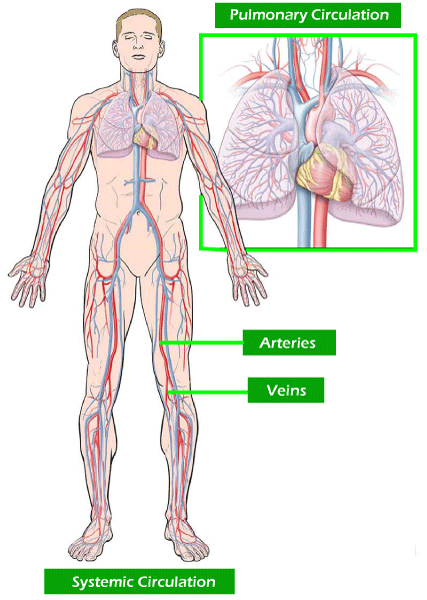Blood CirculationThe movement of blood throughout the body is referred to as blood circulation. The heart and blood vessels are a part of the circulatory system. It is sometimes referred to as the cardiovascular system, where cardio refers to the heart and vascular refers to blood vessels. The circulatory system distributes oxygen, nutrients, and hormones to the body's muscular tissue and organ systems. Additionally, the circulatory system aids in the body's chemical and waste elimination. Blood is circulated throughout the body by the heart through a system of arteries and veins known as blood vessels. Parts of the Circulatory SystemThe parts included in the circulatory system are as follows:
Important Functions of the Circulatory SystemThe circulatory system's primary function is to transport blood throughout the body. Organs, muscles, and tissues function to support human survival. The circulatory system facilitates the body's waste-removal process. Among these wastes are:
Working of the Circulatory SystemThe circulatory system's primary objective is to distribute blood throughout the body using blood vessels such as arteries, veins, and capillaries. The blood vessels circulate blood to the whole body in cooperation with the heart and lungs. 
It includes the following steps:
Types of Circulatory SystemsThere are three circuits in your circulatory system. Blood flows continuously via these circuits, your heart, and other organs:
Types of Blood VesselsArteriesVascular structures called arteries carry blood away from the heart. They have thick walls and a small lumen to withstand the intense pressure caused by the heart's forced contractions. The arteries begin to segment as they move toward the more peripheral tissues, with every division having a smaller diameter and thinner wall. The aorta and the pulmonary artery are the two major arteries that leave the heart. The arteries that supply the heart's tissues with oxygenated blood are known as the coronary arteries. Small and muscular tension vessels, or arterioles, take blood to organ systems, distributing arteries from the heart and their significant branches and conducting arteries with very flexible walls. The conducting arteries have the most significant pressure, which lowers to the afferent arteriole, which has the lowest pressure. The tunica media (mid), tunica external (outside), and tunica intima (inner) are the multiple sections that make up the artery walls. VeinsMuscular venules combine to form veins. Veins have a larger lumen and a thin wall than arteries. The inner layer of the vein contains significantly less muscle than the outermost surface, but the wall structure is comparable to that of arteries. Veins are capacitance vessels, which indicates they have a variable thickness wall and may expand to absorb high amounts of blood. The valves, swellings of the tunica interna into the vascular lumen, are present in most peripheral veins. When the blood flow direction changes, valves are silently closed to stop the blood from flowing backwards into veins. Valves are missing in the thoracic and abdominal veins. CapillariesThe body's tissues are covered in an extensive network of tiny capillaries. Capillaries join arteries and veins altogether. It is where the actual exchange of gases takes place. Oxygen-rich blood is transported from the streets to the capillaries. After passing through capillaries and into veins, the waste blood is delivered to the heart and lungs through circulation. The transfer of gases, nutrients, and wastes is facilitated because capillary walls are densely packed. These capillaries are so fine that red blood cells flow in a single line. Signs of inadequate blood flowPoor circulation has several indications and symptoms, which include:
The signs and symptoms vary according to the type of cardiovascular disorder. For example, the aforementioned leg and foot problems might arise from peripheral arterial disease.
Next TopicBlood Infection
|
 For Videos Join Our Youtube Channel: Join Now
For Videos Join Our Youtube Channel: Join Now
Feedback
- Send your Feedback to [email protected]
Help Others, Please Share










